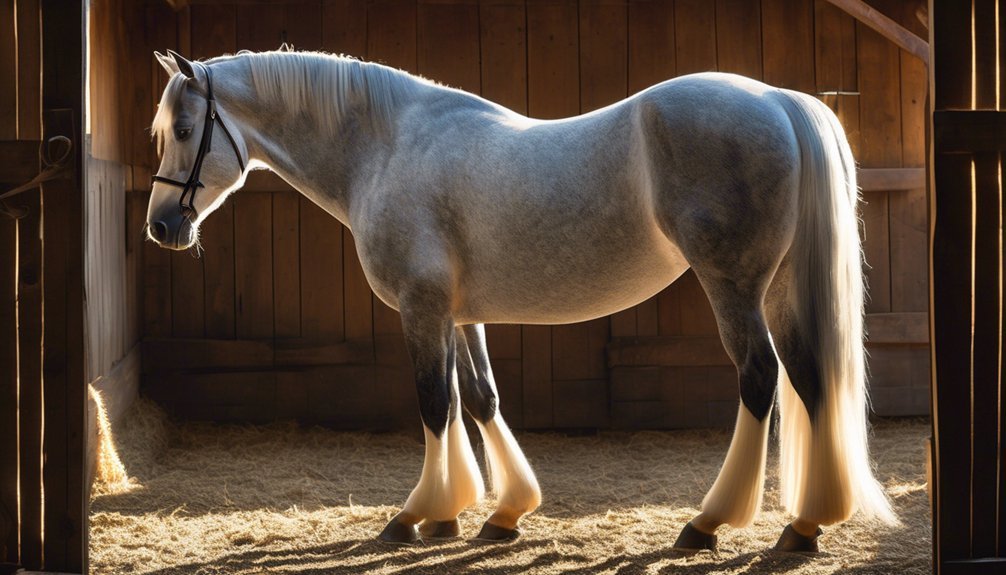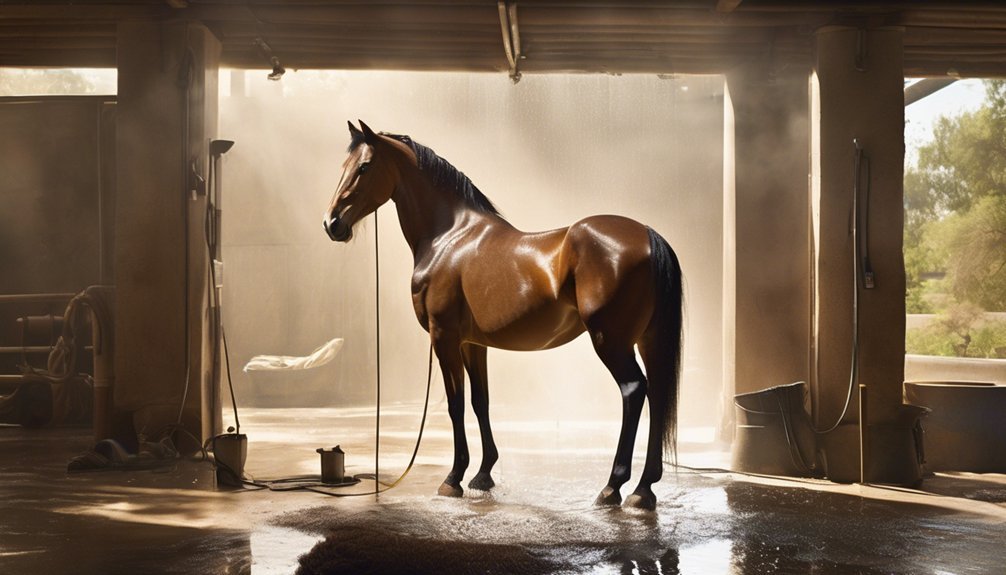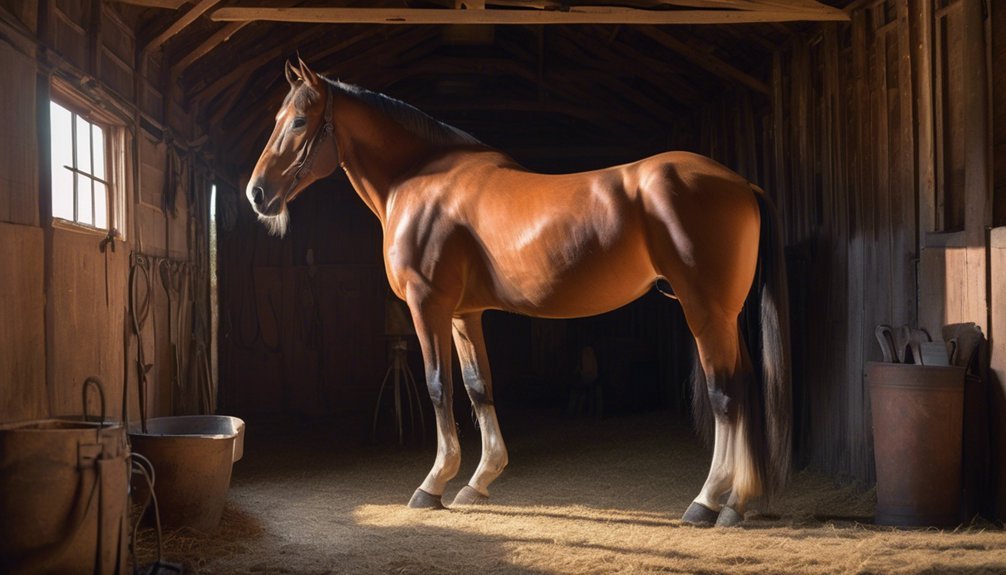
Grooming a short-coated horse is like caring for delicate silk; it requires attention and precision. These horses have sensitive skin that can easily react to temperature changes, making proper grooming essential. You'll want to equip yourself with the right tools and techniques to keep their coat healthy and shiny. But what steps should you take to ensure their skin remains irritation-free? Let's explore the best practices for grooming these unique breeds.
Key Takeaways
- Brush your horse three to four times a week using a curry comb, stiff-bristled brush, and soft brush for optimal coat care.
- Use gentle, moisturizing grooming products to prevent dryness and irritation on your horse's sensitive skin.
- Regularly check your horse for skin conditions and parasites, especially in seasonal changes, to maintain skin health.
- Increase grooming frequency during shedding seasons and use a shedding blade to manage loose hair effectively.
- Provide a clean living environment and a balanced diet rich in omega fatty acids to support overall skin health.
Understanding the Unique Needs of Short-Coated Horses

When it comes to grooming short-coated horses, understanding their specific needs is crucial for maintaining both their health and appearance.
Short coat characteristics often mean these horses lack the insulating layer that longer-haired breeds have, making them more susceptible to temperature fluctuations. You'll need to pay close attention to their skin, as it can dry out or become irritated more easily.
Grooming challenges may arise, such as removing dirt and debris without irritating sensitive skin. Regular brushing with a soft-bristled brush can help, while also stimulating the skin and promoting circulation.
Always check for any signs of skin conditions or parasites, as their short coats may make these issues harder to detect. Caring for their unique needs will keep your horse healthy and comfortable.
Essential Grooming Tools for Short-Haired Breeds
Caring for short-coated horses requires the right set of grooming tools to ensure their skin stays healthy and their coat remains shiny.
You'll want to invest in a few essentials that really make a difference in your grooming routine.
- Grooming brushes: Opt for soft, rubber curry combs that stimulate circulation and remove dirt effectively.
- Shedding tools: A good shedding blade can help remove loose hair, especially during seasonal changes.
- Hoof pick: Keeping hooves clean is crucial for overall health.
- Dandy brush: This stiff brush helps eliminate debris and dust from the coat.
- Soft cloth: Great for polishing and adding shine to your horse's coat.
These tools will help you maintain your horse's appearance and health, fostering a strong bond between you both.
Regular Brushing Techniques for a Healthy Coat

To keep your horse's coat healthy and vibrant, regular brushing is essential. Aim for a brushing frequency of at least three to four times a week, or more if your horse is particularly active or sheds heavily.
Start with a curry comb to loosen dirt and debris, working in circular motions. Follow up with a stiff-bristled brush to remove the loosened dirt, then finish with a soft brush for a polished look.
Don't forget to pay attention to sensitive areas like the face and legs, using gentler strokes. For coat conditioning, consider using a light spray of coat conditioner before brushing; this helps enhance shine and moisture.
Your horse will appreciate your dedicated care, and you'll build a stronger bond through this routine.
Skin Care Tips to Prevent Irritation and Flaking
Maintaining your horse's skin health is crucial, especially if they spend a lot of time outdoors.
Horses with short coats can be prone to skin sensitivity, leading to irritation and flaking. To keep their skin in top condition, here are some practical tips:
- Use gentle, moisturizing products designed for equine skin.
- Apply a soothing balm on areas prone to irritation, especially after riding.
- Regularly check for signs of dryness or flaking, and address them promptly.
- Ensure your horse's environment is clean and free of irritants, like dust or mold.
- Feed a balanced diet rich in omega fatty acids to support skin health from the inside out.
Bathing Guidelines for Short-Coated Horses

After ensuring your horse's skin is healthy and free from irritation, it's time to focus on proper bathing techniques, especially for short-coated horses.
Ideally, you should bathe your horse every 4 to 6 weeks, but adjust the frequency based on their activity level and environment.
When you're ready to bathe, use lukewarm water, as it's comfortable and helps open the pores.
Start by wetting your horse gradually, avoiding the head initially.
Apply a mild shampoo specifically designed for horses, using your hands or a soft sponge to gently massage it in.
Rinse thoroughly to prevent lingering soap residue.
Finish by towel-drying or letting your horse stand in the sun for a natural drying experience.
This routine will keep their coat shiny and healthy.
Seasonal Grooming Considerations
As the seasons change, your grooming routine should adapt to your horse's needs and the environmental conditions.
Seasonal shedding can vary greatly based on climate impact, so you'll want to be proactive in your grooming.
Consider these tips to keep your horse comfortable and healthy:
- Adjust grooming frequency: Increase it during heavy shedding periods.
- Use appropriate tools: A shedding blade can help manage loose hair effectively.
- Monitor skin condition: Watch for dryness or irritation, especially in colder months.
- Stay hydrated: Ensure your horse has access to clean water, especially in warmer weather.
- Maintain a clean environment: Regularly clean your horse's living space to reduce allergens and irritants.
Building a Bond Through Grooming Activities

While grooming your horse might seem like a simple task, it can actually be an invaluable opportunity to strengthen your bond. Establishing consistent grooming routines not only keeps your horse looking great but also fosters trust.
As you gently brush away dirt and debris, take the time to talk softly and share your presence. This creates bonding experiences that deepen your connection. Pay attention to their favorite spots; a gentle scratch behind the ears or along the withers can elicit a relaxed sigh.
Incorporate massage techniques into your grooming sessions, enhancing the experience for both of you. Ultimately, these moments of care and attention will help your horse feel secure and loved, making your relationship flourish.
Frequently Asked Questions
How Often Should I Groom My Short-Coated Horse?
You should groom your short-coated horse at least three times a week for optimal coat maintenance. Consistent grooming frequency helps remove dirt and debris, promotes healthy skin, and strengthens your bond with your horse.
Can I Use Human Shampoo on My Horse?
You shouldn't use human shampoo on your horse due to potential risks like skin irritation and imbalance in natural oils. For optimal horse coat care, stick to products specifically designed for equine skin and coat needs.
What Are the Signs of Skin Irritation?
When you notice skin redness or excessive scratching in your horse, it's vital to act quickly. These signs can indicate irritation or allergies, so check for underlying causes and consult your vet to ensure your horse's comfort.
Do Short-Coated Horses Need Clipping in Summer?
You might think short-coated horses don't need clipping, but summer care is essential. Clipping frequency depends on your horse's activity level and comfort. Regularly assess their coat to ensure they stay cool and healthy.
How Can I Reduce Shedding in My Short-Haired Horse?
To reduce shedding in your short-haired horse, consider dietary adjustments for coat health and use effective grooming tools like rubber curry combs. Regular grooming not only helps manage shedding but also strengthens your bond with your horse.
Conclusion
By grooming your short-coated horse, you're not just maintaining their appearance; you're weaving a tapestry of trust and care between you. Each stroke of the brush symbolizes your commitment to their well-being, nurturing both skin and spirit. As you adapt to their unique needs, remember that this bond strengthens with every grooming session, transforming routine into a shared ritual. Embrace this process, and you'll find that the health of their coat reflects the depth of your connection.





